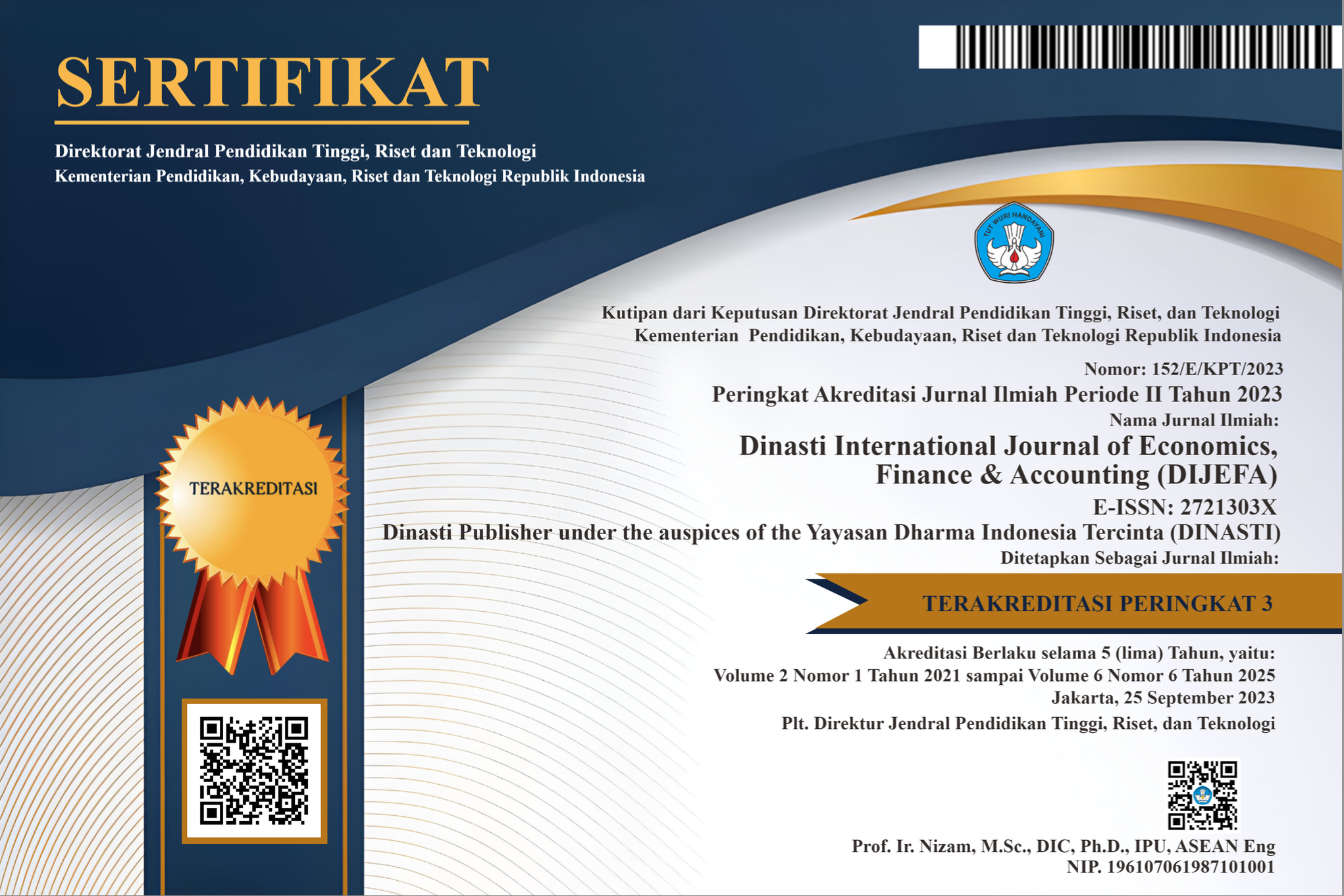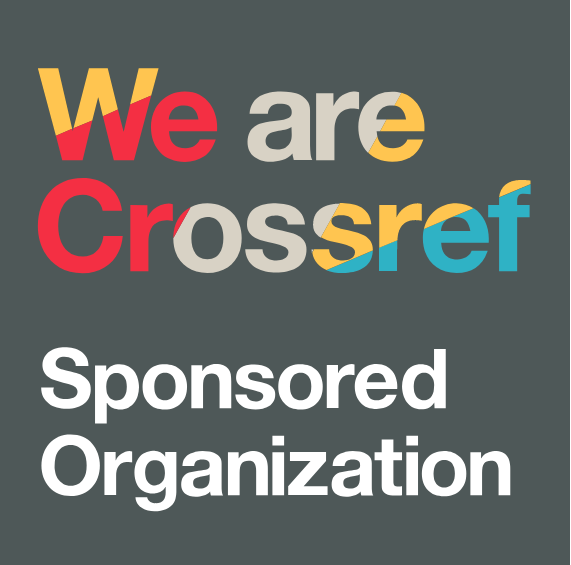Institutional Ownership and Firm Value: Conditional Process Model (CPM)
DOI:
https://doi.org/10.38035/dijefa.v6i3.4703Keywords:
Institutional Ownership, Independent Board of Commissioners, Investment Efficiency, Firm Value, and Conditional Process Model (CPM)Abstract
The effect of institutional ownership on firm value with the conditional process model (CPM) approach: This study aims to test and analyze how and when Institutional Ownership is effective in increasing Firm Value. The research method uses a quantitative approach, the research design uses a descriptive approach, and an explanatory survey to test and analyze causal relationships. Research on public companies in Indonesia in the consumer-non-cyclical sector, as much as 488 pooled times series data with the analysis period 2016-2023, with the Conditional Process Model (CPM) approach to explain how (Mediation effect) and when / under what conditions (moderation effect) the effect occurs on the institutional ownership structure on firm value both directly and indirectly, to estimate the research model using Macro for SPSS V3.4. Research findings: institutional ownership, investment efficiency, and an independent board of commissioners affect increasing the value of the firm, The researcher produced a model formula that institutional ownership of the firm value through investment efficiency, is more visible to the company by involving an independent Board of Commissioners that leads to a high level, and investment efficiency can be used as a mitigation in making investment policies that can produce positive returns, increase the value of the company, so that it can compete sustainably.
References
Agrawal, A., & Mandelker, G. N. (1990). Large Shareholders and the Monitoring of Managers. The Journal of Financial and Quantitative Analysis, 25(2), 143. http://journals.cambridge.org/abstract_S0022109000007080
Akter, A., Wan Yusoff, W. F., & Abdul-Hamid, M. A. (2024). The moderating role of board diversity on the relationship between ownership structure and real earnings management. Asian Journal of Accounting Research, 9(2), 98–115. https://doi.org/10.1108/AJAR-10-2022-0307
Al-Gamrh, B., Ku Ismail, K. N. I., Ahsan, T., & Alquhaif, A. (2020). Investment opportunities, corporate governance quality, and firm performance in the UAE. Journal of Accounting in Emerging Economies, 10(2), 261–276. https://doi.org/10.1108/JAEE-12-2018-0134
Al-hiyari, A., Ismail, A. I., & Kolsi, M. C. (2022). Environmental , social and governance performance ( ESG ) and fi rm investment ef fi ciency in emerging markets?: the interaction effect of board cultural diversity. Corporate Governance International Journal of Business in Society ·, October. https://doi.org/10.1108/CG-03-2022-0133
Al-Janadi, Y. (2021). Ownership Structure and Firm Performance in the Middle East: A Meta-Analysis. Journal of Risk and Financial Management, 14(12). https://doi.org/10.3390/jrfm14120577
Al-Matari, E. M., Al-Matari, Y. A., & Saif, S. A. (2017). Association between ownership structure characteristics and firm performance: Oman evidence. Academy of Accounting and Financial Studies Journal, 21(1).
Al Amosh, H., & Khatib, S. F. A. (2022). Ownership structure and environmental, social and governance performance disclosure: the moderating role of the board independence. Journal of Business and Socio-Economic Development, 2(1), 49–66. https://doi.org/10.1108/jbsed-07-2021-0094
Alghorbany, A., Salau Olarinoye, A., Elaigwu, M., & Che-Ahmad, A. (2024). Does institutional investor influence information technology investment decisions and corporate performance? Cogent Business and Management, 11(1). https://doi.org/10.1080/23311975.2024.2316280
Alvarez, R., Jara, M., & Pombo, C. (2018). Do institutional blockholders influence corporate investment? Evidence from emerging markets. Journal of Corporate Finance, 53, 38–64. https://doi.org/10.1016/j.jcorpfin.2018.09.003
Arora, A., & Sharma, C. (2016). Corporate governance and firm performance in developing countries: evidence from India. Corporate Governance (Bingley), 16(2), 420–436. https://doi.org/10.1108/CG-01-2016-0018
Attig, N., Cleary, S., El Ghoul, S., & Guedhami, O. (2012). Institutional investment horizon and investment-cash flow sensitivity. Journal of Banking and Finance, 36(4), 1164–1180. https://doi.org/10.1016/j.jbankfin.2011.11.015
Bawai, R., & Kusumadewi, H. (2021). Effect of Corporate Governance, Firm Characteristic, Disclosure of Corporate Social Responsibility (CSR) on Firm Value. Jurnal Economia, 17(1), 20–33. https://doi.org/10.21831/economia.v17i1.32523
Bemby S., B., Mukhtaruddin, Hakiki, A., & Ferdianti, R. (2015). Intellectual capital,firm value and ownership structure as moderating variable: Empirical study on banking listed in indonesia stock exchange period 2009-2012. Asian Social Science, 11(16), 148–159. https://doi.org/10.5539/ass.v11n16p148
Bhagat, S., & Bolton, B. (2019). forthcoming , Journal of Corporate Finance Corporate Governance and Firm Performance?: The Sequel Sanjai Bhagat University of Colorado at Boulder April 2019 Please address correspondence to [email protected] We thank seminar participants at the U. Journal of Corporate Finance, 58(October), 142–168.
Biddle, G. C., Hilary, G., & Verdi, R. S. (2009). How does financial reporting quality relate to investment efficiency?? Journal of Accounting and Economics, 48(2–3), 112–131. https://doi.org/10.1016/j.jacceco.2009.09.001
Boshnak, H. A. (2023). Ownership structure and firm performance: evidence from Saudi Arabia. Journal of Financial Reporting and Accounting, March. https://doi.org/10.1108/JFRA-11-2022-0422
Cahyaningdyah, D., & Ressany, Y. D. (2012). Pengaruh Kebijakan Manajemen Keuangan Terhadap Nilai Perusahaan. Jurnal Dinamika Manajemen, 3(1), 20–28. https://doi.org/10.52644/joeb.v13i2.1559
Chen, N., Sung, H.-C., & Yang, J. (2017). Ownership structure, corporate governance and investment efficiency of Chinese listed firms. Pacific Accounting Review, 29(3), 266–282. https://doi.org/10.1108/par-12-2015-0046
Cho, M. H. (1998). Ownership structure, investment, and the corporate value: an empirical analysis. Journal of Financial Economics, 47(1), 103–121.
Demsetz, H., & Lehn, K. (1985). The Structure of Corporate Ownership: Causes and Consequences. Readings in Applied Microeconomics: The Power of the Market, 93(6), 1–439. https://doi.org/10.4324/9780203878460
Din, S. U., Arshad Khan, M., Khan, M. J., & Khan, M. Y. (2022). Ownership structure and corporate financial performance in an emerging market: a dynamic panel data analysis. International Journal of Emerging Markets, 17(8), 1973–1997. https://doi.org/10.1108/IJOEM-03-2019-0220
Duong, H. K., Wu, Y., Schiehll, E., & Yao, H. (2024). Environmental and social disclosure, managerial entrenchment, and investment efficiency. Journal of Contemporary Accounting and Economics, 20(3). https://doi.org/10.1016/j.jcae.2024.100435
Fahlenbrach, R., & Stulz, R. M. (2009). Managerial ownership dynamics and firm value. Journal of Financial Economics, 92(3), 342–361. https://doi.org/10.1016/j.jfineco.2008.06.005
Farrer, J., & Ramsay, I. M. (1998). Director Share Ownership and Corporate Performance - Evidence from Australia. Corporate Governance: An International Review, 6(4), 233–248. https://doi.org/10.1111/1467-8683.00112
García-García, L., Gonzalo Alonso-Buenaposada, M., Romero-Merino, M. E., & Santamaria-Mariscal, M. (2020). Ownership structure and R&D investment: the role of identity and contestability in Spanish listed firms. Academia Revista Latinoamericana de Administracion, 33(3–4), 405–426. https://doi.org/10.1108/ARLA-01-2019-0013
García-Sánchez, I. M., Aibar-Guzmán, C., & Aibar-Guzmán, B. (2020). The effect of institutional ownership and ownership dispersion on eco-innovation. Technological Forecasting and Social Change, 158(June), 120173. https://doi.org/10.1016/j.techfore.2020.120173
Hadiprajitno, P. (2013). STRUKTUR KEPEMILIKAN, MEKANISME TATA KELOLA PERUSAHAAN, DAN BIAYA KEAGENAN DI INDONESIA (Studi Empirik pada Perusahaan di Bursa Efek Indonesia). Jurnal Akuntansi Dan Auditing, 9(2), 97–127. https://doi.org/10.14710/jaa.v9i2.4789
Hamdan, A. (2018). Board interlocking and firm performance: the role of foreign ownership in Saudi Arabia. International Journal of Managerial Finance, 14(3), 266–281. https://doi.org/10.1108/IJMF-09-2017-0192
Hayes, A. (2022). Introduction to Mediation, Moderation, and Conditional Process Analysis. A Regression-Based Approach (David A. Kenny (ed.); Third Edit). THE GUILFORD PRESS. A Division of Guilford Publications, Inc.
Hermalin, B., & Weisbach, M. (1991). The Effects of Board Composition and Direct Incentives on Firm Performance. Financial Management Association International, 20(4), 101–112.
Hidayat, R., Wahyudi, S., Muharam, H., & Zainudin, F. (2020). Institutional ownership, productivity sustainable investment based on financial constrains and firm value: Implications of agency theory, signaling theory, and asymmetry information on sharia companies in Indonesia. International Journal of Financial Research, 11(1), 71–81. https://doi.org/10.5430/ijfr.v11n1p71
Himmelberg, C., Hubbard, G., & Palia, D. (1999). Understanding the determinants of managerial ownership and the link between ownership and performance: Comment. In Journal of Financial Economics (Vol. 53). https://doi.org/10.1016/S0304-405X(01)00085-X
Igartua, J. J., & Hayes, A. F. (2021). Mediation, Moderation, and Conditional Process Analysis: Concepts, Computations, and Some Common Confusions. Spanish Journal of Psychology, 24(6), 1–23. https://doi.org/10.1017/SJP.2021.46
Iturriaga, F. J. L., & Sanz, J. A. R. (2001). Ownership Structure , Corporate Value and Firm Investment?: A Simultaneous Equations Analysis of Spanish Companies. Journal OfManagement and Governance, 5, 179–204.
Jensen, M. (1986). Agency Costs of Free Cash Flow , Corporate Finance , and Takeovers. The American Economic Review, 76(2), 323–329. http://www.jstor.org/stable/1818789 .
Jensen, M., & Meckling, W. (1976). THEORY OF THE FIRM: MANAGERIAL BEHAVIOR, AGENCY COSTS AND OWNERSHIP STRUCTURE. Journal of Financial Economics, 3(10), 305–360. https://doi.org/10.1177/0018726718812602
Jiang, L., Cherian, J., Sial, M. S., Wan, P., Filipe, J. A., Mata, M. N., & Chen, X. (2021). The moderating role of CSR in board gender diversity and firm financial performance: empirical evidence from an emerging economy. Economic Research-Ekonomska Istrazivanja , 34(1), 2354–2373. https://doi.org/10.1080/1331677X.2020.1863829
Jumanne, B. B., & Keong, C. C. (2018). Ownership concentration, foreign ownership and corporate performance among the listed companies in East African community: the role of quality institutions. African J. of Accounting, Auditing and Finance, 6(1), 70. https://doi.org/10.1504/ajaaf.2018.10012250
Li, J., Lam, K., Qian, G., & Fang, Y. (2006). The effects of institutional ownership on corporate governance and performance: An empirical assessment in Hong Kong. Management International Review, 46(3), 259–276. https://doi.org/10.1007/s11575-006-0047-0
Liu, Y., Lei, L., & Buttner, E. H. (2020). Establishing the boundary conditions for female board directors ’ influence on firm performance through CSR. Journal of Business Research, 121(February 2019), 112–120. https://doi.org/10.1016/j.jbusres.2020.08.026
Liu, Y., Miletkov, M. K., Wei, Z., & Yang, T. (2015). Board independence and firm performance in China. Journal of Corporate Finance, 30, 223–244. https://doi.org/10.1016/j.jcorpfin.2014.12.004
López Iturriaga, F. J., & López-Millán, E. J. (2017). Institutional framework, corporate ownership structure, and R&D investment: an international analysis. R and D Management, 47(1), 141–157. https://doi.org/10.1111/radm.12204
Mackinnon, D. P., Fairchild, A. J., & Fritz, M. S. (2007). Mediation Analysis. The Annual Review OfPsychology, 58, 593–614. https://doi.org/10.1146/annurev.psych.58.110405.085542
Memon, M. A., Cheah, J. H., Ramayah, T., Ting, H., & Chuah, F. (2018). Mediation analysis issues and recommendations. Journal of Applied Structural Equation Modeling, 2(1), I–IX. https://doi.org/10.47263/JASEM.2(1)01
Mirza, S. S., Majeed, M. A., & Ahsan, T. (2019). Board gender diversity, competitive pressure and investment efficiency in Chinese private firms. Eurasian Business Review, 10(3), 417–440. https://doi.org/10.1007/s40821-019-00138-5
Mishra, R., & Kapil, S. (2017). Effect of ownership structure and board structure on firm value: evidence from India. Corporate Governance (Bingley), 17(4), 700–726. https://doi.org/10.1108/CG-03-2016-0059
Morck, R., Shleifer, A., & & Vishny, R. (1988). Management ownership and market valuation. An empirical analysis. Journal of Financial Economics, 20(C), 293–315. https://doi.org/10.1016/0304-405X(88)90048-7
Mukaria, H. K., Mwangi, M., Ochieng, D. E., & Okiro, K. (2020). Mediating Effect of Agency Cost on the Relationship between Ownership Structure and Firm Value. Journal of Finance and Investment Analysis, 9(3), 37–50.
Munisi, G., Hermes, N., & Randøy, T. (2014). Corporate boards and ownership structure: Evidence from Sub-Saharan Africa. International Business Review, 23(4), 785–796. https://doi.org/10.1016/j.ibusrev.2013.12.001
Naeem, K., & Li, M. C. (2019). Corporate investment efficiency: The role of financial development in firms with financing constraints and agency issues in OECD non-financial firms. International Review of Financial Analysis, 62(December 2018), 53–68. https://doi.org/10.1016/j.irfa.2019.01.003
Nirino, N., Battisti, E., Ferraris, A., Dell’Atti, S., & Briamonte, M. F. (2022). How and when corporate social performance reduces firm risk? The moderating role of corporate governance. Corporate Social Responsibility and Environmental Management, 29(6), 1995–2005. https://doi.org/10.1002/csr.2296
Ong, T. S., Zhou, J., Teh, B. H., & Di Vaio, A. (2024). Equity ownership concentration’s impact on corporate internal control: the moderating effects of female directors and board compensation. Environment, Development and Sustainability, 26(5), 12309–12337. https://doi.org/10.1007/s10668-023-03795-9
Ozdemir, O., Vegas, L., Erkmen, E., & Binesh, F. (2021). Board diversity and firm risk-taking in the tourism sector?: Moderating effects Board diversity and firm risk-taking in the tourism sector?: Moderating effects of board independence , CEO duality , and free cash flows. May. https://doi.org/10.1177/13548166211014367
Panda, B., & Leepsa, N. M. (2017). Agency theory: Review of theory and evidence on problems and perspectives. Indian Journal of Corporate Governance, 10(1), 74–95. https://doi.org/10.1177/0974686217701467
Perwito, P., Nugraha, N., Disman, D., & Gunardi, G. (2021). Intangible Asset Moderation and the Sustainable Investment and Firm Value Relation. BIS-HSS. https://doi.org/10.4108/eai.18-11-2020.2311719
Perwito, P., Nugraha, N., Mayasari, M., & S, Y. (2023). The Moderating Role of Board Independent in Managerial Ownership and Firm Value: Evidence in Indonesia. Jurnal Ilmiah Akuntansi Dan Bisnis, 18(1), 58. https://doi.org/10.24843/jiab.2023.v18.i01.p05
Putra, F. (2024). Good corporate governance, firm performance and COVID-19. Asian Journal of Accounting Research, 9(4), 399–421. https://doi.org/10.1108/AJAR-07-2023-0227
Rajkovic, T. (2020). Lead independent directors and investment efficiency. Journal of Corporate Finance, 64, 101690. https://doi.org/10.1016/j.jcorpfin.2020.101690
Randøy, T., & Goel, S. (2003). Ownership structure, founder leadership, and performance in Norwegian SMEs: Implications for financing entrepreneurial opportunities. Journal of Business Venturing, 18(5), 619–637. https://doi.org/10.1016/S0883-9026(03)00013-2
Rashid, M. M. (2020). “Ownership structure and firm performance: the mediating role of board characteristics.” Corporate Governance (Bingley), 20(4), 719–737. https://doi.org/10.1108/CG-02-2019-0056
Richardson, S. (2006). Over-investment of free cash flow. Review of Accounting Studies, 11(2–3), 159–189. https://doi.org/10.1007/s11142-006-9012-1
Rizqia, D. A., Aisjah, S., Program, P., & Java, E. (2013). Effect of Managerial Ownership , Financial Leverage , Profitability , Firm Size , and Investment Opportunity on Dividend Policy and Firm Value. 4(11), 120–130.
Rungtusanatham, M., Miller, J. W., & Boyer, K. K. (2014). Theorizing , testing , and concluding for mediation in SCM research?: Tutorial and procedural recommendations. Journal of Operations Management, 32(3), 99–113. https://doi.org/10.1016/j.jom.2014.01.002
Sahrul, M., & Novita, S. (2020). Ownership Structure, Firm Value and Mediating Effect of Firm Performance. Jurnal Akuntansi, 24(2), 219. https://doi.org/10.24912/ja.v24i2.692
Salehi, M., Zimon, G., Arianpoor, A., & Gholezoo, F. E. (2022). The Impact of Investment Efficiency on Firm Value and Moderating Role of Institutional Ownership and Board Independence. Journal of Risk and Financial Management, 15(4). https://doi.org/10.3390/jrfm15040170
Siddique, M., Rasheed, A., & Rehman, K. U. (2022a). Role of Research and Development Innovation between Ownership Structure and Firm Performance. Human Nature Journal of Social Sciences, 3(3), 57–70. http://hnpublisher.com
Siddique, M., Rasheed, A., & Rehman, K. U. (2022b). THE MEDIATING ROLE OF CORPORATE SOCIAL PERFORMANCE BETWEEN. Pakistan Journal of Social Research, 4(3), 172–185.
Siswanti, I., & Prowanta, E. (2021). Struktur Kepemilikan dan Nilai Perusahaan pada Perusahaan Manufaktur yang Terdaftar di Bursa Efek Indonesia. Jkbm (Jurnal Konsep Bisnis Dan Manajemen), 7(2), 179–190. https://doi.org/10.31289/jkbm.v7i2.4842
Toumeh, A. A., Yahya, S., & Amran, A. (2023). Surplus Free Cash Flow, Stock Market Segmentations and Earnings Management: The Moderating Role of Independent Audit Committee. Global Business Review, 24(6), 1353–1382. https://doi.org/10.1177/0972150920934069
Ullah, I., Zeb, A., Khan, M. A., & Xiao, W. (2020). Board diversity and investment efficiency: evidence from China. Corporate Governance (Bingley), 20(6), 1105–1134. https://doi.org/10.1108/CG-01-2020-0001
Usaini, M., & Wooi, H. (2023). the Effect of Corporate Governance on Earnings Management in Nigeria’S Financial Institutions: Moderating Role of Ceo Competency. Malaysian Management Journal, 27, 21–58. https://doi.org/10.32890/mmj2023.27.2
Vijayakumaran, R. (2021). Impact of managerial ownership on investment and liquidity constraints: Evidence from Chinese listed companies. In Research in International Business and Finance (Vol. 55). Elsevier B.V. https://doi.org/10.1016/j.ribaf.2020.101321
Wati, L. N., Primiana, H. I., Pirzada, K., & Sudarsono, R. (2019). Political connection, blockholder ownership and performance. Entrepreneurship and Sustainability Issues, 7(1), 52–68. https://doi.org/10.9770/jesi.2019.7.1(5)
Wu, S., Li, X., Du, X., & Li, Z. (2022). The Impact of ESG Performance on Firm Value: The Moderating Role of Ownership Structure. Sustainability (Switzerland), 14(21), 1–22. https://doi.org/10.3390/su142114507
Zaid, M. A. A., Abuhijleh, S. T. F., & Pucheta-Martínez, M. C. (2020). Ownership structure, stakeholder engagement, and corporate social responsibility policies: The moderating effect of board independence. Corporate Social Responsibility and Environmental Management, 27(3), 1344–1360. https://doi.org/10.1002/csr.1888
Downloads
Published
How to Cite
Issue
Section
License
Copyright (c) 2025 Perwito P, Rita Zulbetti, Rifqi. A Muabrok, Ilham Setiawan, Rezqya. A Azyuranie

This work is licensed under a Creative Commons Attribution 4.0 International License.
Authors who publish their manuscripts in this journal agree to the following conditions:
- The copyright on each article belongs to the author(s).
- The author acknowledges that the Dinasti International Journal of Economics, Finance & Accounting (DIJEFA) has the right to be the first to publish with a Creative Commons Attribution 4.0 International license (Attribution 4.0 International (CC BY 4.0).
- Authors can submit articles separately, arrange for the non-exclusive distribution of manuscripts that have been published in this journal into other versions (e.g., sent to the author's institutional repository, publication into books, etc.), by acknowledging that the manuscript has been published for the first time in the Dinasti International Journal of Economics, Finance & Accounting (DIJEFA).


























































